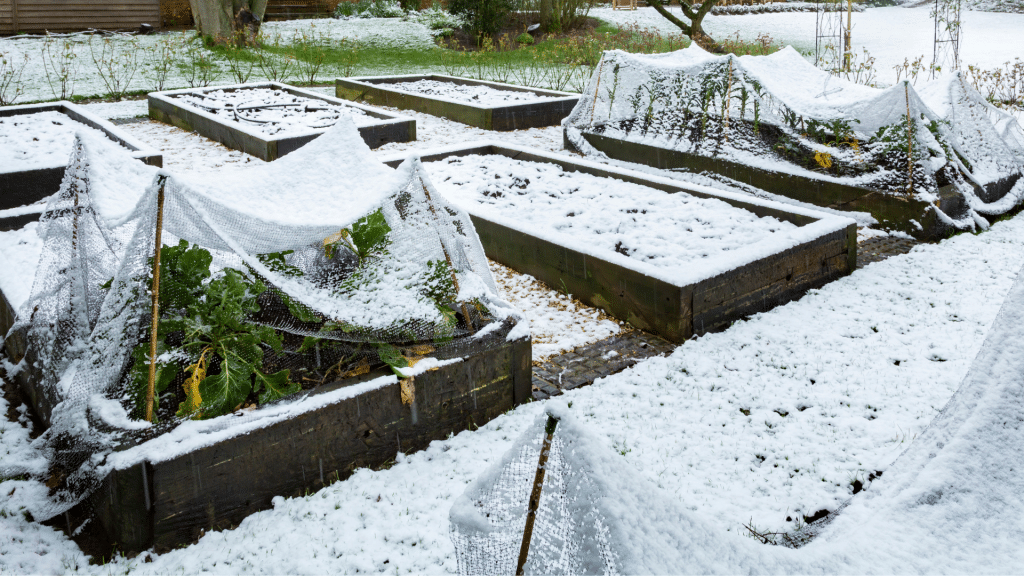Get ready to embark on a thrilling journey of winter vegetable gardening. Where chilly temperatures don't mean waving goodbye to your green thumb dreams! In this blog, we're diving into the essentials of cultivating a vibrant winter garden that defies the frosty odds. Wondering when to plant those hardy veggies or how to give them the cozy care they deserve? We've got you covered with practical tips for a bountiful winter harvest. From soil prep to choosing the coolest plant varieties. Let us make your winter gardening journey not just successful but downright enjoyable.
Get your smart self stirring mug ready and join us as we unlock the door to a world where winter and veggies coexist in harmony.
Understanding the Basics of Winter Vegetable Gardening
Winter vegetable gardening is a rewarding endeavor that allows enthusiasts to extend their gardening season, grow vegetables and enjoy fresh produce even in winter long months. While many may associate gardening with the warmth of spring and summer, with the right knowledge and preparations, winter gardening can be just as fruitful.
Cold weather gardening presents a unique set of challenges, but it can be a fulfilling and productive experience with the right mindset. Understanding the specific needs of and adapting your gardening practices accordingly is the first step towards winter growing success.
Choosing the Right Vegetables in Winter
Not all vegetables are ideal to grow in winter conditions, so choosing varieties known for their extreme cold and weather resistance is crucial.
Leafy Greens:
Leafy greens are nutrient-packed vegetables that thrive in cooler weather, offering a range of vitamins, minerals, and antioxidants essential for overall health. Examples of winter salad greens include kale, mustard greens and swiss chard which are known for their high nutrient content, and spinach. This versatile green adds both flavor and nutritional value to various winter dishes. These leafy greens can survive cold temperatures.
Brussels Sprouts:
Brussels sprouts, belonging to the brassica vegetables family, are excellent choices for winter gardens due to their cold-resistant nature. These robust winter crops tolerate cold temperatures and thrive in hard freezes. The harvest season for these winter marvels typically extends into late fall and early winter, providing a nutritious and flavorful addition to your winter garden bounty.
Broccoli:
Broccoli is an excellent choice for winter gardens, especially in areas with mild climates. This cold-tolerant vegetable thrives when temperatures drop, making it well-suited for cultivation during the cold season. With its ability to withstand cooler weather, broccoli can be a rewarding addition to your winter gardens, providing a fresh and nutritious harvest even in chilly conditions.
Cauliflower:
Cauliflower is an ideal addition to winter gardens, thriving in cool temperatures and even tolerating light frost. This cruciferous vegetable can be grown during the winter months, providing a fresh and nutritious harvest. To ensure successful cultivation, consider using protective covers such as row cover or frost blankets, which shield the cauliflower plants from the chillier elements, allowing them to flourish despite the winter conditions.
Carrots:
Winter carrots are a classic winter root vegetable, rich in beta-carotene and vitamin A. They can be roasted, sautéed, or added to soups, providing a natural sweetness and vibrant color to winter dishes while contributing to eye health and immune function.
Turnips:
Turnips are a hardy root vegetable with a slightly peppery flavor. They can be boiled, mashed, or roasted, and their greens can be sautéed for added nutrition. Turnips are a good source of vitamin C, fiber, and essential minerals.
Winter Squash:
Butternut squash, a type of winter squash, is rich in vitamins A and C, as well as fiber. Its sweet, nutty flavor makes it perfect for roasting, soups, and purees, adding warmth and nutrition to winter meals.
Spinach:
Although spinach is available year-round, it thrives in cooler temperatures. This leafy green is a versatile addition to winter salads, soups, and casseroles, providing iron, vitamins A and C, and other essential nutrients for a healthy diet.
Bulbs:
Consider planting bulbs of cold-tolerant vegetables in winter for an early spring harvest. Garlic is an excellent choice, as it requires a period of cold to form bulbs properly and is typically planted in late fall or early winter. Onions and shallots also thrive when planted in late or early autumn, establishing roots during the colder months and yielding an early spring bounty with proper care.
These hardy vegetables not only add variety and flavor to your meals but also contribute essential nutrients to support your overall health during the colder months.
Preparing Your Winter Vegetable Garden
Choose the Right Vegetables:
Select cold hardy vegetables that thrive in colder temperatures. Consider options like kale, Brussels sprouts, broccoli, carrots, and squash. Check your local climate to determine the best varieties for your region. Choose vegetables that are perfect for light frosts or cold-tolerant ones.
Plan Your Garden Layout:
Organize your garden beds to make the most of available sunlight. Place taller crops on the northern side of the garden to avoid shading shorter plants. Consider companion planting to enhance growth and deter pests.
Soil Preparation for Cold Success
The foundation of a successful winter garden lies in soil preparation. Enhance your soil with organic matter, such as compost, to improve drainage and provide essential nutrients. Well-draining soil prevents waterlogging, a common issue in winter that can harm plant roots.
Mulching for Temperature Regulation
Mulching is a key practice in winter gardening. A thick layer of mulch helps regulate soil temperature, providing insulation for plant roots against extreme cold. Additionally, mulch helps retain moisture, reducing the risk of dehydration during dry winter spells.
Proper Watering:
Proper watering in is crucial for maintaining plant health despite the cooler temperatures. While plants experience reduced water loss through evaporation, monitoring soil moisture levels is essential. Water plants deeply but less frequently, allowing the soil to dry out slightly between watering to prevent waterlogged conditions that can lead to root rot during the dormant season.
Water less ! Know that winter usually means less watering. Plants grow a little more slowly and there's often winter rains, so be careful to avoid underwatering. Adjusting your watering routine to match the specific needs of winter conditions helps ensure the well-being of your plants throughout the colder months.
Protect from Frost:
Be prepared to protect your plants from frost. Protecting your vegetables from harsh weather is crucial. Cover sensitive crops with frost blankets or row covers during cold nights. Consider using a cold frame, row covers or cloches for added insulation. Row covers and cold frames protect against freezing temperatures and biting winds especially in regions with harsh winter conditions. These structures create a microclimate that supports plant growth while safeguarding against the challenges of winter weather.
Succession Planting for Continuous Harvest
Implementing succession planting ensures a continuous supply of fresh produce throughout the winter. By staggering the planting of certain crops, you can extend your harvest window and enjoy a diverse array of vegetables over an extended period of cold season.
Monitor and Control Pests:
Keep an eye out for pests that may still be active in winter. Aphids, cabbage worms, and other pests can damage your crops. Use natural predators, such as ladybugs, or apply organic insecticides if necessary or use floating row covers to protect your precious plants from pests.
Understanding Winter Planting Windows
Timing is everything in cold weather gardening. Start by calculating the average first frost date in your region, then work backward to determine the ideal planting dates for winter crops. Planting too early or too late can compromise the success of growing vegetables in cold weather.
When to Plant:
Early Fall Planting (Late Summer to Early Fall): Plant winter vegetables 6-8 weeks before the first expected frost in your area. This timing allows the plants to establish themselves before colder temperatures set in, promoting better hard freezes resilience.
Late Fall Planting: Extend your planting into late fall based on the frost dates in your region. This strategic timing ensures a steady supply of fresh produce throughout the winter months.
How to Plant:
Prepare the Soil: Ensure your soil is well-drained and enriched with organic matter by incorporating compost. This step promotes optimal growing conditions for winter vegetables.
Choose the Right Varieties: Select winter-hardy varieties specifically bred for cold climates. This ensures that the plants can withstand mild winters and thrive in lower temperatures.
Planting Depth and Spacing: Follow recommended planting depths for each vegetable type and provide proper spacing. This practice encourages healthy growth and minimizes your established plants' disease risk by allowing for adequate air circulation.
Caring for Your Winter Garden
Monitoring Moisture Levels
Winter's chill and cool weather can create dry conditions, so monitoring soil moisture levels is essential. Watering during dry spells is crucial, but be cautious not to overwater, as soggy soil can lead to root rot. Use a moisture meter or simple finger test to assess watering needs.
Pest Control in Cold Weather
While winter temperatures may deter some pests, certain insects thrive in colder conditions. Keep an eye out for pests like aphids and caterpillars, and use organic pest control methods to protect your winter vegetables without resorting to harmful chemicals.
Harvesting Your Winter Bounty
Knowing When to Harvest
Each winter vegetable has its own optimal harvest time. Pay attention to the recommended days to maturity for your chosen crops, and use visual cues such as color and size to determine when they are ready to be picked. Harvesting at the right time ensures the best flavor and nutritional content.
Storing Vegetables in Winter
Proper storage is crucial for maintaining the quality of your winter harvest. Root vegetables can be stored in a cool, dark place, while greens are best kept in the refrigerator. Consider preserving excess produce through methods like freezing or pickling to enjoy the flavors of your winter garden year-round.
Conclusion: A Winter Garden Worth the Effort
In conclusion, winter vegetable gardening doesn't need to be an icy challenge; it's an exciting opportunity to enjoy fresh produce even when the weather turns chilly. Remember to time your planting right, starting in early fall and considering late fall options based on your frost dates. Getting your hands dirty? The way to go is to prepare that soil with love – well-drained and nutrient-rich. Choosing the right winter-hardy varieties is like picking the coziest sweater for your veggies. And, just like bundling up in layers, use mulch to keep the soil snug and row covers for that extra frosty protection.
These tips are your golden ticket to a bountiful harvest, bringing the taste of success to your winter vegetable garden. Embrace the winter gardening challenge, and you'll discover a world of flavors and freshness that extends far beyond the traditional growing season. Happy winter gardening!

